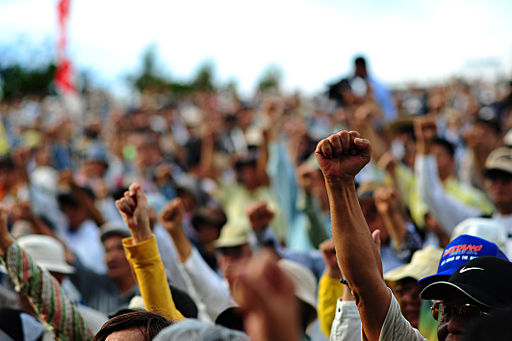
We are all familiar with the marquee protests in American history: the 1963 March on Washington, the 1969 anti-Vietnam War protest, and the 2017 post-inaugural Women's March. This weekend in Los Angeles, the #MeTooMarch will be protesting the normalizing of rape culture. With the recent bizarre acceptance by many Republicans of Roy Moore, who has a well-sourced history of pedophilia, issue-responsive protests like this are growing more urgent, frequent, and necessary.
With all of this renewed activism in the U.S. and recent Democratic victories in off-year elections, it's important to remember and learn from what has worked in the past. Brittany Shoot wrote a great piece in Atlas Obscura on an often overlooked but highly impactful protest that involved no marching at all. The fact that the protestors were disabled –some physically, some mentally – didn't stop them from conducting the longest non-violent occupation of a federal building in United States history, the 504 Sit-In.
What they accomplished bettered millions of lives to this day. If you're interested in understanding what it takes to effect major changes in policy, or get inspired to do something, this well-written piece about the 26-day long sit-in is worth a few minutes of your time:
(Read Brittany Shoot's full article here)
The Rehabilitation Act of 1973 included the little-noticed Section 504, which was based on the 1964 Civil Rights Act and mandated integration of people with disabilities into mainstream institutions. But the language was broad, only noting that “no qualified individual with a disability should, only by reason of his or her disability, be excluded from the participation in, be denied the benefits of, or be subjected to discrimination under any program or activity receiving Federal financial assistance.” By 1977, disability rights activists weary of asking nicely for their civil rights, decided to move—into the HEW offices [Health, Education, and Welfare], that is.
“At that time in history, there was simply no access—no right to an education, no public transit. You couldn’t get into a library or city hall, much less a courtroom,” says 504 Sit-In participant, author, and disability rights advocate Corbett Joan O’Toole. She notes that as late as the 1970s, there were no federally mandated social services or agencies for individuals living with disabilities. If an individual wanted to hire an in-home attendant or interpreter, it had to happen through pre-existing social networks.
The interdependency of the group itself, along with the cooperation of other social justice groups, like The Black Panther Party, was significant and very relevant now:
O’Toole notes that people with disabilities—as well as people who are also part of other marginalized populations such as the LGBT community—are accustomed to the type of cooperative interdependence that was necessary for 504. The 100-plus occupiers and their attendants made the building their own almost immediately, draping a window air conditioning unit with a plastic tarp to create a makeshift refrigerator for medications and using the pay phones to communicate with loved ones and news media on the outside until the FBI cut the lines. There were daily consensus-driven committee meetings about everything from media strategy to how to respond to a bomb scare false alarm, in the event the FBI employed tactics to evacuate the building. “Disabled people are incredibly resourceful,” O’Toole says. “That is a commonly misunderstood and overlooked part of our history, and it led to the success of 504.”
“They [the Black Panther Party] understood what it meant to support a revolutionary movement that wasn’t just on the street with weapons,” O’Toole says, pointing to the Party’s groundbreaking Free Breakfast for Children initiative, which eventually served a reported 20,000 low-income children and influenced federal guidelines for free breakfast and lunch programs still vital in the nation’s public schools.
Under 504, nondiscrimination became a legal, fundamental right. Within months of the sit-in, noticeable changes began to take place in urban landscapes, in university classrooms, in the workplace, and in public spaces including libraries, courtrooms, and public transit. Cities instituted curb cuts from street to sidewalk. Federal buildings made adjustments to become accessible to all, including installing ramps and wider restroom stalls. Regulations instituted as a result of the success of 504, ushered in a new era of accessibility that led to the passage of Americans With Disabilities Act in 1990.
Image: Nathan Keirn


